Magnificent, under-rated Málaga
Thursday, October 26, 2023

Málaga [Photo: spain.info]
Wow! We just spent three days in Málaga City and what a revelation!
OK, there are lots of roadworks and building sites in the centre of the city, which are a bit of a nuisance. But they will no doubt turn out to be a good thing in the longer term.
No, the area around Plaza de La Merced, just north of the Casco Antiguo, is a delight. There were lots of tourists, even in late October, and it was expensive to eat and drink, but, hey, shit happens – look at Ronda, where we live. During the day full of coachloads of tourists from all over the world, but early and late in the day, still a dream.
We found an affordable hotel near this central square, so everything was set for a relaxed couple of days.
Then, disaster struck - l realised I’d left my wallet behind, at home (I hope!) All I had on me was a little cash and no cards.
Rita to the rescue …..
Málaga for two
We opted to arrive a day early, on the Monday. After check-in at the Homeabout La Merced apartments and parking the car, we went out to investigate. We grabbed a drink at the emblematic El Pimpi before grabbing a bite to eat in a delightful little restaurant in a side street. Name of Santa Monica. A shared salad and a couple of tapas each did the trick.
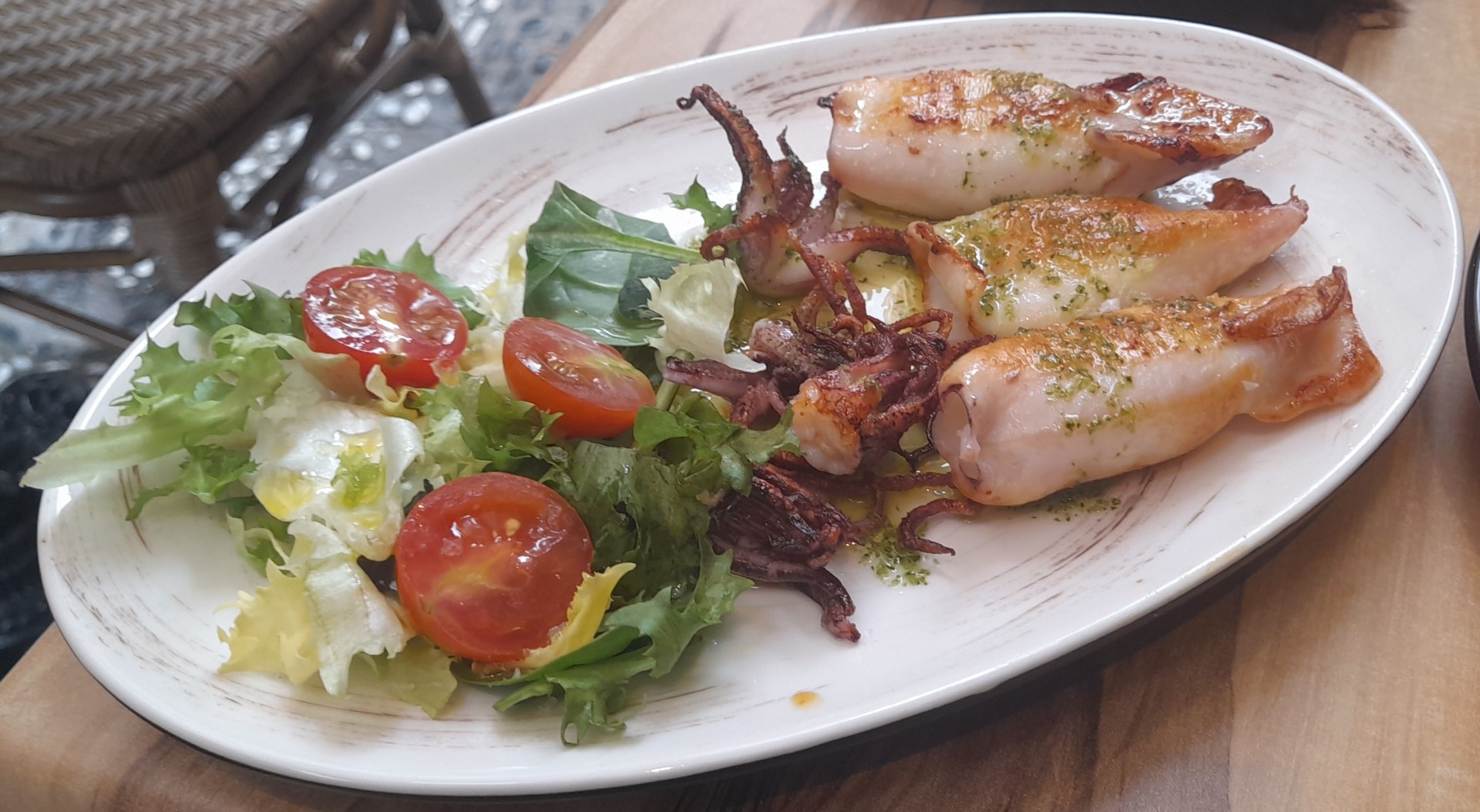 
Calamares [Photo: Paul Whitelock]
Teryaki de atun [Photo: Paul Whitelock]
Then it was off for a wander around the Old Part before a short siesta back at our hotel.
In the evening, we went to the Trip Advisor-recommended El Cortijo de Pepe. We started off sitting on the terrace, but the waitress advised us to move inside when it started to rain.
We ate well: calamar relleno de cerdo, and two tapas to share. Delicious. Our waiter, Saul, a young man from Teba, not far from Ronda, was very friendly and talkative. A great end to the day.
The Port of Málaga
This down-on-its-luck former industrial port has recently had a make-over. Compare Barcelona, Bilbao, Bristol, Hamburg, Liverpool, London, Salford, Valencia. All have had tourism-boosting upgrades.
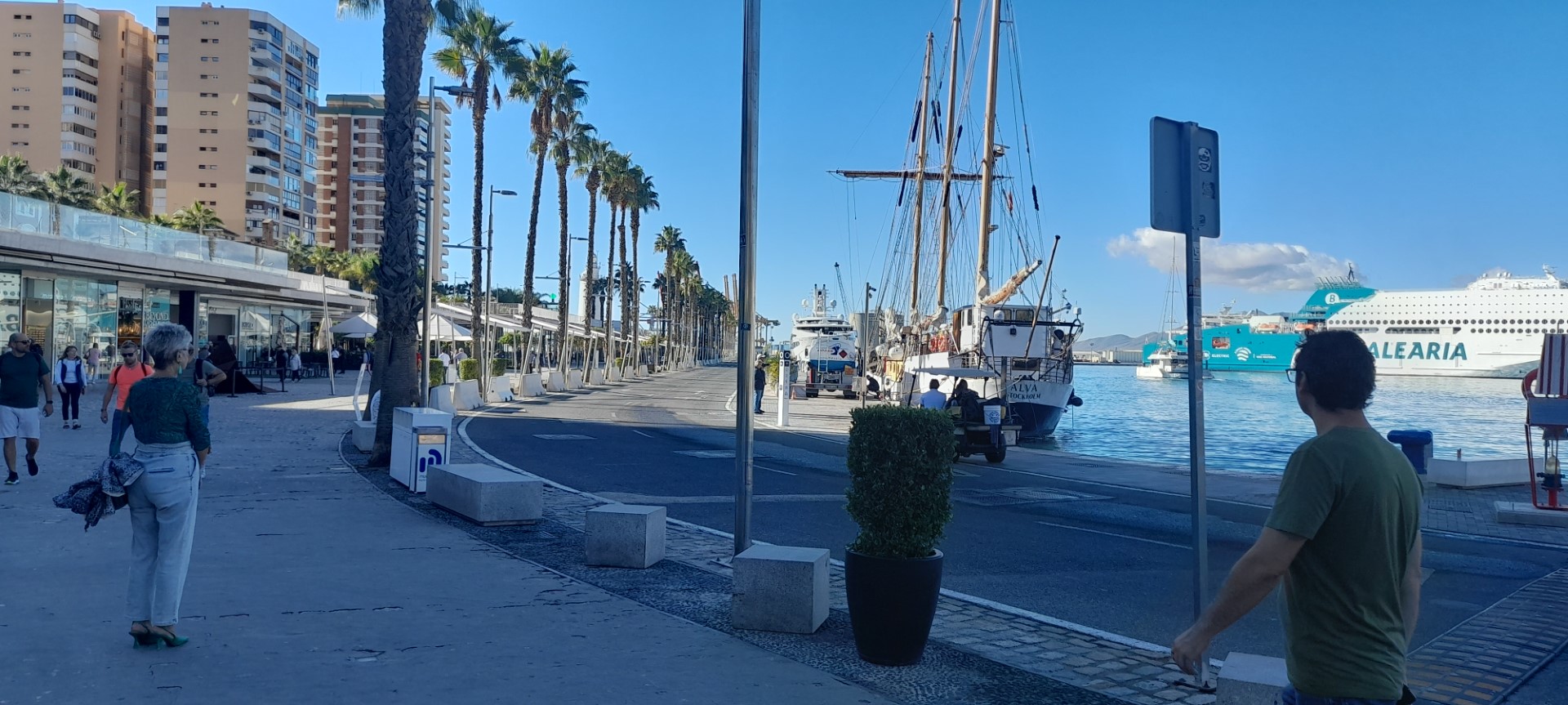
Within walking distance of our apartment, we spent a good hour in the morning wandering around the souvenir stalls, restaurants and boutiques, eyes on stalks at the prices!
We spotted a branch of one of our favourite café chains, Granier, and resolved to return for breakfast there on our last morning.
Málaga port [Photo: Paul Whitelock]
At the far end we landed on one of Málaga’s town beaches, La Malagueta. We had a pre-prandial beer in the eponymous chiringuito set on the beach, in order to rest our weary legs before heading back into town.
Later I had my hair cut. I’d been wearing it long for a year or so and had even grown a bit of a ponytail, but it was time for me to get it cut, so that’s what I did. Rita was delighted.
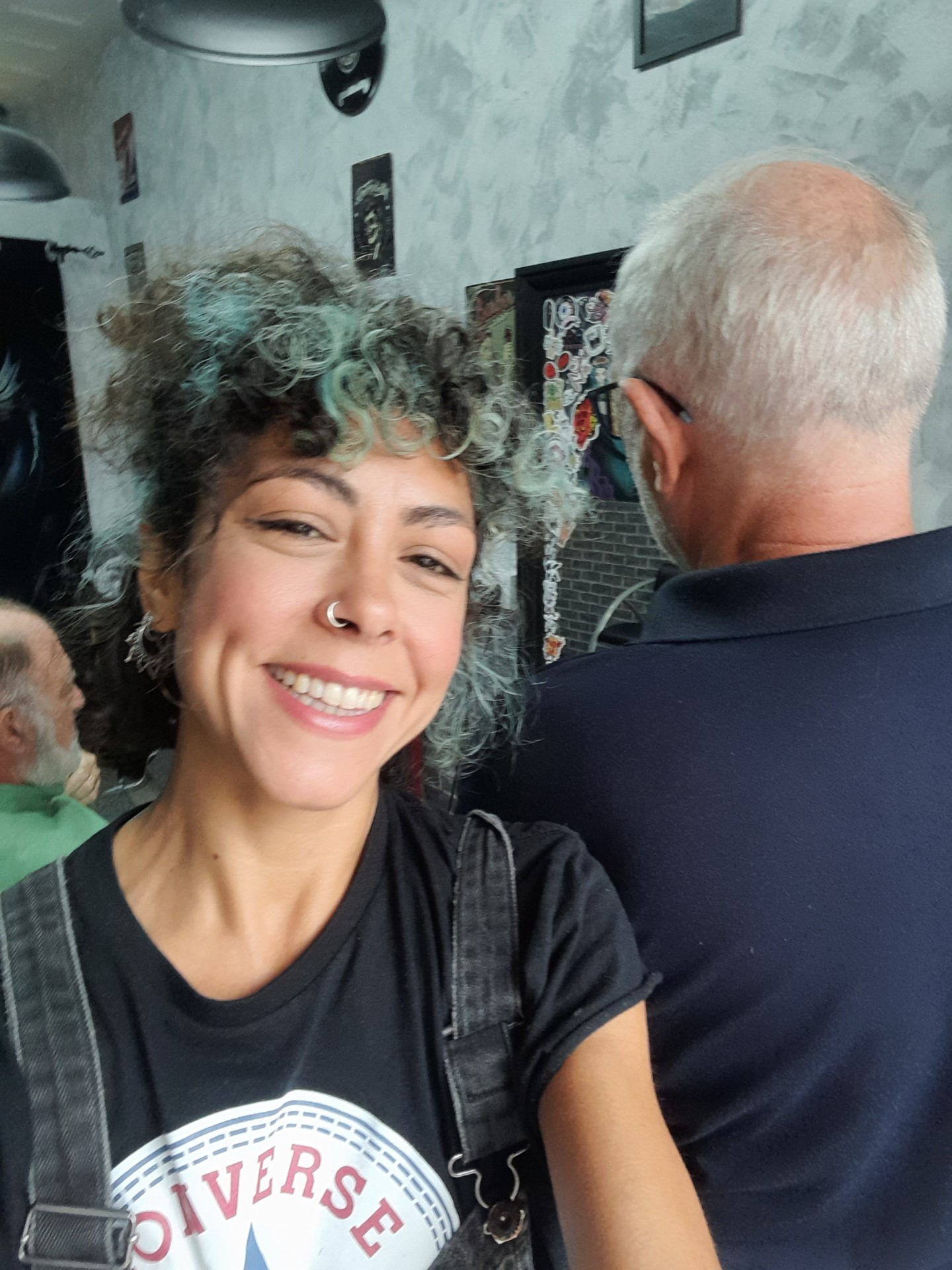 
The Spanish Fly with hairdresser Lorena [Photos: selfies]
Picasso, son of Málaga

Members of the Costa Press Club and guests posing with Pablo Picasso [Photo: Karl Smallman]
Pablo Ruiz Picasso, born in the city in 1881, is arguably Málaga’s most famous son, although he lived most of his 80-something years in France.
 He is the reason we were in Málaga. I’m a member of the Club de Prensa Costa del Sol, the Costa Press Club. This association of journalists, writers, and media folk from all over the world meets approximately once a month for an “activity” and a meal. The association celebrated its 20th anniversary in 2022. He is the reason we were in Málaga. I’m a member of the Club de Prensa Costa del Sol, the Costa Press Club. This association of journalists, writers, and media folk from all over the world meets approximately once a month for an “activity” and a meal. The association celebrated its 20th anniversary in 2022.
We move around for our meetings: Fuengirola, Málaga, Marbella, Mijas, Puerto Banus, and dine in a good restaurant each time. Before the meal we usually have a speaker on some topic related to our field of activity, but for the October 2023 meeting, we started off with a guided tour of the small Picasso Museum in Plaza de La Merced, 50 steps from his Casa Natal, his birth house, also a museum.
Entitled “La Imagen de Picasso”, this new exhibition focused on his relationship with the media, film, photography, books, newspapers, etc. With photographs, some never seen before, and film and documentary extracts, this was a fascinating insight into the life of one of Spain’s most popular and controversial artists.
A known womaniser, this tiny, but charismatic little man, was always in the news. His output was prolific and his body of work represents a number styles during different periods of his life. Some of his stuff was not to everyone’s taste, but his contribution to 20th Century art is undeniable.
My favourite is Guernica. I’ve seen the original and I had a great poster copy from when I was a student. When my first marriage broke up nearly 20 years ago, it disappeared. I re-discovered it years later on the wall of my daughter’s flat in London. She still has it.
But I unearthed a much smaller framed copy in a junk shop in Ronda a couple of years ago, and I’m happy with that.
Eme de Mariano
A short walk from the museum brought us to our restaurant in the Old Part.
 We were 23 members and guests, and we had our own private area. We were 23 members and guests, and we had our own private area.
The meal was mainly a shared buffet of delights, including croquetas, ensaladilla rusa, salchichón, and tartare de atún, but we had individual portions of gazpachuela and arroz con chistorra or arroz negro con pescado y mariscos. By the time the postre came we were well stuffed! All washed down with two glasses of wine, beer or un refresco, included in the price.
The staff were friendly, polite and efficient. The girls were beautiful, especially Rocío, my favourite.
In fact, we found all restaurant staff to be pleasant throughout our mini-break.
The walk back to the hotel was hard. Apart from having full stomachs, I was wearing brand new shoes. Silly boy!
Breakfast at Tiffany’s Granier
Granier is a chain of bakers-cum-cafés with great bread and brilliant breakfasts. Not cheap, but a nice treat from time to time.
 
We used to have a Granier in Ronda, but, inexplicably, it closed down. Down here on the coast, there are Graniers all over the place – Fuengirola, Los Boliches, Málaga, Marbella, San Pedro de Alcántara.
We chose the branch in the Port of Málaga, that we had discovered the previous day.
After checking out of the hotel, we walked there. It was busy, but no problem. We had a great breakfast, and a large cup of coffee for around 20€. Quite expensive, but delish!
Then we walked back to the hotel, picked up the car and hit the road back home to Ronda.
Epilogue
We had a great three days: explored the old part of Málaga a bit more; ate good food; enjoyed the new exhibition devoted to Picasso; and re-acquainted ourselves with other members of the Costa Press Club, among them a German, an Argentinian and sundry British folk. I was somewhat alarmed to find that I was the oldest man present. Fortunately, Rita was not the oldest lady.
© The Spanish Fly
Photos:
All unacknowledged photos by The Spanish Fly
Tags:
Casa Natal, Costa Press Club, Eme de Mariano, Fuengirola, Granier, Karl Smallman, Los Boliches, Málaga, Marbella, Mijas, Pablo Ruiz Picasso, Paul Whitelock, Picasso, Plaza de la Merced, San Pedro de Alcántara, Spanish Fly
 3
Like
Published at 6:46 PM Comments (2)
3
Like
Published at 6:46 PM Comments (2)
Extremadura – Journey to the hard extreme – Part 2 - 2021
Thursday, October 26, 2023
The Spanish Fly has visited Extremadura twice – once just over 20 years ago and again just recently. In Part 1 he described his first visit with his first wife and son in 2002. In Part 2 he covers the five-day visit he and his second wife Rita made in 2021.
Introduction
19 years since my last visit it was time for me to rediscover Extremadura. This time I wanted to check out all seven of the paradores located in the region. And I wanted to show my wife Rita this beautiful part of Spain located slightly off the beaten track.
Once again, I bought a Five-Night Card. This cost just 600€. That works out at 120€ per night, breakfast included, and 20 per cent discount on all food purchased in the parador.
 I am also an Amigo de Paradores which means there are certain perks like discounted parking, a welcome drink on arrival, and occasional special offers such as tours or other activities. I am also an Amigo de Paradores which means there are certain perks like discounted parking, a welcome drink on arrival, and occasional special offers such as tours or other activities.
In addition, for every 3 euros spent you get a point. And what do points mean? Prizes!
Well in the case of this loyalty scheme, you can exchange points for accommodation or meals. In the old days I had many a free night’s accommodation for my accumulated Amigo points.
Sunday 3 October 2021
On this trip we stayed in different paradores than my previous trip, except for Zafra, the most southerly one, which is just three hours from Ronda. So, we spent the first night there.

The parador is in a 15th century castle-palace built on the remains of an Arab fortress. Rita loved it.
We paid a small supplement to get upgraded to a larger room.
After a stroll through the old part and a light lunch in the Plaza Chica, just off the Plaza Mayor, we took a siesta before dressing up for dinner. We ate well in the parador restaurant, Rita “maining” on lomo de ternera and me on a leg of baby goat. Mmmm!
Parador de Zafra (Photo: Paul Whitelock)
Monday 4 October 2021
The following morning, after a hearty breakfast, we had a look around Zafra before heading north.
We called in to look at the parador in Plasencia – a 15th century former monastery. Beautiful. It was very busy, so we didn’t stay long.
A further hour’s drive brought us to our parador for the night, in Jarandilla de la Vera. Well, we thought Zafra and Plasencia were both excellent, but Jarandilla was simply stunning. A 15th century castle-cum-palace, it seemed perfect in every way.
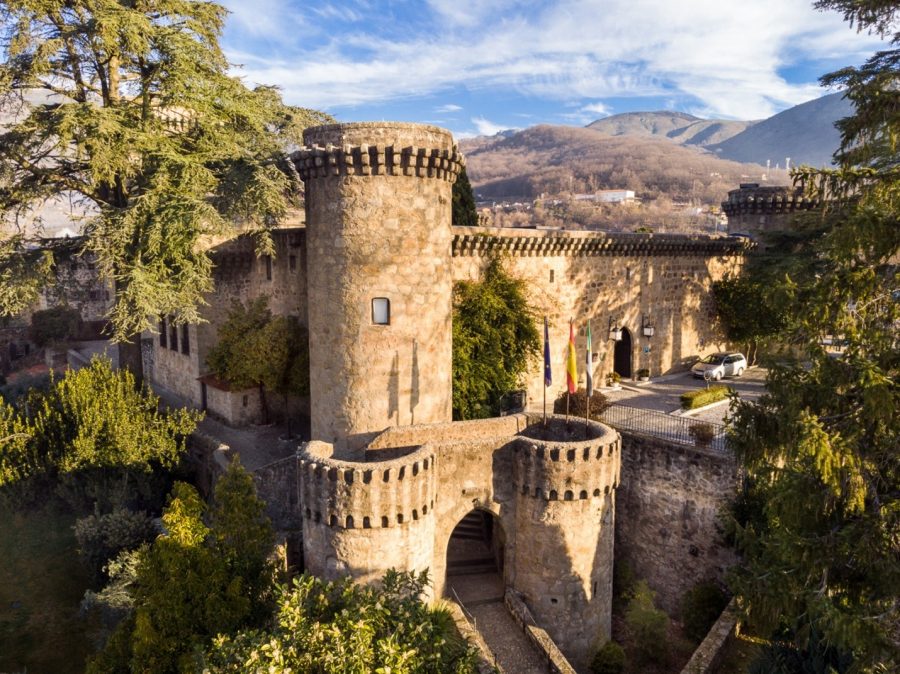
After a very late lunch (ca. 5.00 pm) we took some photos and wandered around the sleepy town. Then after a short siesta, it was time to eat again!
The parador restaurant was packed! Once again, our dinner was excellent.
We try to focus on local dishes, so we shared a partridge salad before we both had poached salmon with a dressing of crema de espinacas on a bed of boulanger potatoes. Washed down with a bottle of locally produced Sauvignon Blanc. Muy rico.
Parador de Jarandilla de la Vera (Photo: Karl Smallman)
Tuesday 5 October 2021
Day 3 began with another huge breakfast, before we headed off to Guadalupe to check out the parador there. I had been before, 19 years ago, but for Rita it was new.
Such a pretty parador, a former hospital (15th century), with a gorgeous patio full of lemon trees.
We went to see the Black Virgin in the basilica before returning to the parador for lunch in the aforementioned patio.
We shared two dishes: an ensalada de naranjas and vieiras gratinadas (coquilles St Jacques). Just right.
Then it was on to Trujillo, our resting place for the next two nights.

The parador here, a former castle, stands at the top of the town. It is just a few minutes’ walk to the impressive Plaza Mayor, which boasts an imposing statue of Francisco Pizarra, born here and the conqueror of Peru.
The first night we dined in the parador restaurant. The food was unremarkable, so much so that I can’t even remember what we had.
Parador de Trujillo (Photo: Karl Smallman)
Wednesday 6 October 2021
We drove to Cáceres to check out the parador and the city. The zona monumental, where the parador is located, was a delight. Lots of old buildings and narrow cobbled streets largely free of traffic.
The Cáceres parador was old on the outside and modern inside. Not our favourite, but clearly popular with others, as to stay there with the Five-Night Card you must pay a supplement of 60€!
We had lunch at a restaurant in the Plaza Mayor. I had a menu of the day and Rita chose carrilleras (carrilladas or pork cheeks to us!)
We drove on ordinary roads back to the parador in Trujillo and had a rest before ambling down to the square for a light dinner in the Plaza Mayor there. Just to make a change from the somewhat samey parador offer.
Thursday 7 October 2021

After breakfast in Trujillo, we drove to Mérida, parked at the parador, checked in and went for a nice, relaxed lunch in the patio. The parador here was an 18th century convent and very spacious.
After a siesta we went for a stroll and took some nice photos of the Alcazaba (9th century Arab fortress) and the Roman bridge.
Parador de Merida (Photo: Karl Smallman)
The menu at the parador offered some things we’d not previously had, so we dined in. What a good decision. We shared a starter, beef croquetas , then Rita had atún con algas (tuna with seaweed) and I chose filete de dorada (gilt head bream). A couple of glasses of a local white and we were well set for a good night’s sleep!
Friday 8 October 2021
As is my wont, I went in search of an early morning coffee.
Finding a café open early when away from home is easier said than done, however. In a couple of places on this tour of Extremadura it has entailed walking or driving around darkened streets until I spotted shadowy figures huddled together outside a dimly lit bar.
Here in Mérida, it was easy; I just headed for the Plaza de España, five minutes’ walk from the parador, and the Bar Arcada was waiting for me with open arms.
Full of regulars and early work starters, as are all early bars, it’s great fun to listen in and sometimes to join in. Trouble is, once they find out I’m British, they only want to talk about – you guessed it – BREXIT! No Spaniard understands why we would want to leave the EU. Them and me both!
After our final hearty breakfast for a while, we packed, paid the bill, and loaded the car.
Then it was off to do a bit of Roman culture. We headed for the theatre and the amphitheatre where we got to use our tarjeta sesentaycinco for the first time to get a 50% discount on the price of admission.
The restoration of these two Roman monuments has been tastefully done and the results are really stunning. We passed a good hour there and took some great photos.
After a bit of window shopping on the way back to the car, we said our farewells to Mérida before setting off back to Andalucía and Ronda.
It probably sounds like we had a hedonistic week, over-indulging on delicious food. Well, we did, but surprisingly I hadn’t put on a single gramme in weight!
Conclusion
We had a fabulous week, well deserved after a tough year at the hands of Covid-19.
We visited all seven paradores in Extremadura and stayed in four.
Our favourite paradores were (in alphabetical order):
Guadalupe; Jarandilla de la Vera; Mérida; Trujillo and Zafra
Our favourite towns were:
Cáceres; Guadalupe; Mérida and Trujillo.
© The Spanish Fly
Tags:
Amigo de paradores, Cáceres, Covid-19, Extremadura, Five-night card, Guadalupe, Jarandilla de la Vera, Mérida, parador, paradores, Paul Whitelock, Pizarra, Plasencia, Spain, Trujillo, Zafra
 0
Like
Published at 10:48 AM Comments (0)
0
Like
Published at 10:48 AM Comments (0)
Extremadura – Journey to the hard extreme – Part 1 - 2002
Thursday, October 26, 2023
The Spanish Fly has visited Extremadura twice. Once about 20 years ago and again at the end of last year (2022) - each time with different travelling companions. In 2002 with first wife Jeryl and son Tom; last year with second wife Rita.
In Part 1 he describes his first visit in 2002.
The Paradores Five-Night Card
 I went on a parador tour to Extremadura in 2002 with my first wife Jeryl and my son Tom. We had a Five-Night card which gave us five nights’ accommodation at a discounted rate. I can’t remember how much we paid back then - could have been 400€ - but it seemed like a bargain at the time. Especially as we stayed in some fantastic places. I went on a parador tour to Extremadura in 2002 with my first wife Jeryl and my son Tom. We had a Five-Night card which gave us five nights’ accommodation at a discounted rate. I can’t remember how much we paid back then - could have been 400€ - but it seemed like a bargain at the time. Especially as we stayed in some fantastic places.
Plasencia
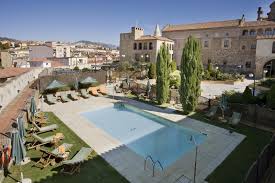
We flew to Madrid, picked up a really dodgy hire car and headed west. First stop was Plasencia. The parador there is in the former convent of Santo Domingo dating from the 15th century. What a stunning place.
The day got even better when I discovered that my favourite Spanish group, Radio Tarifa, was due to play in the square that night. What an amazing coincidence! I had no idea when I planned our trip.
This multi-national music ensemble, combined Flamenco, Arab-Andalusian music, Arabic music, Moorish music and other musical influences of the Mediterranean, the Middle Ages and the Caribbean.
 The name Radio Tarifa comes from an imaginary radio station in Tarifa, a small town in the Spanish province of Cádiz, Andalusia, the closest part of Spain to Morocco. The name Radio Tarifa comes from an imaginary radio station in Tarifa, a small town in the Spanish province of Cádiz, Andalusia, the closest part of Spain to Morocco.
And what a great concert it was! In the interval I approached the bass player, who I knew was English, and had a great chat. David Purdye, a Geordie, had joined the band as a temporary replacement. Despite having no Spanish, he was still with the band several years later ….. and loving it.
I was to see the group perform live twice more, later that year in the huge capacity Bridgewater Hall in Manchester and a year later in a sports hall in Warrington, with a capacity of about 50. Down on their luck, or what?
Radio Tarifa split up in 2006, their lead singer and driving force died in 2012 and that was effectively that for this unique band. They left a great legacy though! I listen to them often.
After two nights in Plasencia we headed into the hills to Guadalupe.
Guadalupe
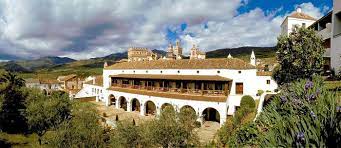
The parador here also dates from the 15th century, but this time it was a former hospital, St John the Baptist. Simple, but delightful, with extensive gardens. The basilica here is home to the black virgin of Guadalupe.
Zafra

Our final stop was Zafra, where the parador is in an old castle, also dating from the 15th century. The internal patio, used as the restaurant, was a charming place to sit and eat the delicious local food.
Two nights there and it was off back to Madrid to catch our flight home to Manchester.
What a great week! A truly Magical History Tour.
© The Spanish Fly
Tags:
Black virgin, convent of Santo Domingo, David Purdye, Extremadura, Five-Night Card, Guadalupe, Madrid, Manchester, Morocco, parador, Plasencia, Radio Tarifa, St John the Baptist, Tarifa, Zafra
 0
Like
Published at 8:24 AM Comments (0)
0
Like
Published at 8:24 AM Comments (0)
Beginning at the beginning
Tuesday, October 24, 2023
By The Spanish Fly
Well, it took nearly 60 years but I made it in the end!
Obviously, when I was born in 1950 I didn’t yet know that Spain was to be my destiny; nor when I went to primary school and later to two different grammar schools, where only French, German and Latin were on offer. I did all three.

When I was 17, I didn’t know that Spain was to be my destiny either, as I was preparing to apply to study French and German at university. Then at my second interview for my first-choice uni they offered me the chance to start a new language ab initio, instead of either French or German, in exchange for a lower grade offer! The deal was done – I chose Spanish instead of French (don’t ask me why…) and the rest is history!
The early years
So as I fetch up on Las Ramblas in Barcelona at the ripe young age of 20 to start my year abroad, I am stunned by this exotic new world of seedy, noisy, but exciting Mediterranean life in the Catalan port city in 1970.
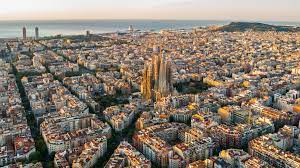 After an exciting weekend in the Catalan capital (not that you would have known it was Catalan back then, since Franco was still very much alive and outlawing all public use of the local language), we set off – seven of us – in a hire car to drive across northern Spain to San Sebastián (Guipúzcoa) in the Basque Country, where we were due to spend three months studying at the university there. After an exciting weekend in the Catalan capital (not that you would have known it was Catalan back then, since Franco was still very much alive and outlawing all public use of the local language), we set off – seven of us – in a hire car to drive across northern Spain to San Sebastián (Guipúzcoa) in the Basque Country, where we were due to spend three months studying at the university there.
We’d planned to do the journey by rail, but it was Easter and all the trains were fully booked. So, we hired a big car – a large SEAT. One snag – I was the only one of us with a driving licence!
One full day later – no motorways back then – and we arrived late at night in San Sebastián with nowhere to stay. However, Miss Pilling – we didn’t know her first name – who’d done Spanish A level at school and was better at Spanish than the rest of us, who were all beginners, soon sorted us out with a fonda in the Parte Vieja (Old Part).
Tired as we were we couldn’t resist going out for a drink. When we discovered that a glass of wine was only one peseta a glass (less than 1p), it became much more than one drink! We thought we were in heaven, and with delicious pintxos (tapas) at only five pesetas and Santana’s “Black Magic Woman” on the jukebox, the night was long.
So was the next day. I was very ill in the night (must have been the effort of the long drive… he says!) and the next morning my nausea mixed with the smell of fish and the sea air made for a hangover I have yet to repeat in the following 50 years!
But I was in Spain, and it was fantastic, if only because it was so different to anywhere else I’d ever been, which actually wasn’t anywhere much at that time.
After the hangover
The first night in San Sebastián had been an orgy of cheap wine, pintxos and Santana. This led to the worst hangover of my life.
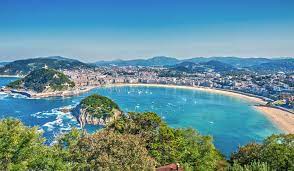 By the time I am fit to drink alcohol again two days later, the price of wine has doubled to two pesetas a glass! That’s one hundred per cent inflation! The locals are up in arms, but we don’t care, as it is still ridiculously cheap, less than 2d (<1p). By comparison a pint in the UK in 1970 was about two shillings (10p). By the time I am fit to drink alcohol again two days later, the price of wine has doubled to two pesetas a glass! That’s one hundred per cent inflation! The locals are up in arms, but we don’t care, as it is still ridiculously cheap, less than 2d (<1p). By comparison a pint in the UK in 1970 was about two shillings (10p).
Once we are billeted with families, the only affordable option, we spend the next three months enjoying our new surroundings and new life. Typically, mornings are spent on the beautiful beach of Playa de la Concha, afternoons at lectures and evenings in the Old Part checking out the range of delicious pintxos and monitoring the price of the wine, before heading back to our digs for dinner prepared by our landlady Maria Nieves, Snow White as we call her!
The three months go quickly by, after which we are left to our own devices for three months. I’d got myself work in the office of a local tour operator, which eventually turns into a job as a guide collecting British and Irish pilgrims from Lourdes in France and showing them the high life of this most beautiful of the Basque cities.
After my six months’ sojourn in Spain, it’s off to Stuttgart, Germany, for a placement as a translator at Daimler-Benz, the car manufacturer. But Germany just isn’t the same and I miss the carefree, life-on-the-streets ambience of España.
The next several summers are spent repping back in Lourdes/San Seb, before the demands of a job in teaching and marriage make it too difficult to sustain.
Over the next several decades we (my wife and subsequently our two children) explore most parts of Spain through holidays and business trips. Although the country changes dramatically and quickly after the death of the dictator Franco in November 1975, it remains a great attraction for us all. Over the years our jobs take us to Madrid, Barcelona and Oviedo (Asturias) for short visits, which enables us to experience something other than the sand, sea and sun of the ever more ghastly development of the costas.
A New Life in Andalucía
After three decades of regular visits to Spain, it gets to the millennium and 25 years of married life.
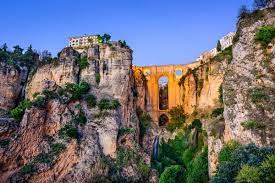 So, in summer 2000 my wife and I decide to celebrate our silver wedding anniversary by touring Andalucía, a region we don’t yet know. Flight to Málaga, two nights in spectacular Ronda, two in stunning Arcos de la Frontera, a sherry tour in tranquil Jerez de la Frontera, via beautiful Carmona to two more nights in gorgeous Córdoba, surely the best of the big three Andalucían cities (Sevilla, Granada and Córdoba), then via Roman Antequera back to bustling Málaga. We are both hooked on the region and decide to spend some of an upcoming windfall on a property in the Serranía de Ronda. So, in summer 2000 my wife and I decide to celebrate our silver wedding anniversary by touring Andalucía, a region we don’t yet know. Flight to Málaga, two nights in spectacular Ronda, two in stunning Arcos de la Frontera, a sherry tour in tranquil Jerez de la Frontera, via beautiful Carmona to two more nights in gorgeous Córdoba, surely the best of the big three Andalucían cities (Sevilla, Granada and Córdoba), then via Roman Antequera back to bustling Málaga. We are both hooked on the region and decide to spend some of an upcoming windfall on a property in the Serranía de Ronda.
The following year, 2001, after several further visits to the area and lots of viewings, we buy a little apartment in the San Francisco barrio of Ronda, which we enjoy as a family for a number of years until life takes a sharp turn in a different direction.
After redundancy, early retirement and divorce in 2005 I am able to spend lengthy periods in Ronda, this beautiful cliff-top town. Over a couple of years, I do up two houses, one for me and one for my new girlfriend, Maude. I get to know lots of people, locals and immigrants alike. The social life is something I’d always craved, but never really had before, apart from when I was a student in San Sebastian, over three decades earlier.
Then finally in 2008, my somewhat chaotic life sorts itself out, everything comes together at the right time, I meet my little German Fräulein Rita and I am able to fulfil my dream of moving to Spain to live full-time.
So here I am, married again, to Rita, and living contentedly in her little old house in one of the white villages near Ronda, dabbling in a bit of writing and translating and feeling a lot younger than the 60 years old I become in 2010!
Epilogue: La carne de burro no es transparente
Life quickly settles down in Mo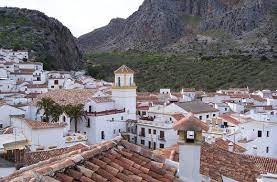 ntejaque, the beautiful village near Ronda where I am living with my German wife, Rita, who I sometimes refer to as the Meter Maid, for reasons which should be obvious to fans of The Beatles. ntejaque, the beautiful village near Ronda where I am living with my German wife, Rita, who I sometimes refer to as the Meter Maid, for reasons which should be obvious to fans of The Beatles.
After a short spell at The Olive Press newspaper, during which time I also contribute articles to SUR in English, the Euro Weekly News and Olive Country Life magazine, the latter based in Alcalá La Real (Jaén), I become a blogger.
I get myself a website to promote my various activities, namely translating and interpreting, holiday rentals and house sales. The blog is a ruse to attract potential clients to my website.
 In the meantime, after three years we leave our little house in the village and move to the campo just outside Ronda. I get a garden, Rita gets a pool and we both get a house you can reach by car, which means no more schlepping shopping up the hill to the house in Montejaque. In the meantime, after three years we leave our little house in the village and move to the campo just outside Ronda. I get a garden, Rita gets a pool and we both get a house you can reach by car, which means no more schlepping shopping up the hill to the house in Montejaque.
I am invited to write a blog for the online version of The Olive Press and for another local website, now defunct. As time goes on I grow disillusioned with translating. It’s boring being cooped up indoors with a laptop and a dictionary. And interpreting at the hospital, at the bank, at the lawyer’s becomes a nightmare in that many clients don’t really want an interpreter, they want someone to solve their medical, financial or legal problems. So, I give that all up. I continue to help out friends in exchange for a cup of coffee or a breakfast, but that’s a different kettle of fish. The house sales don’t really work too well either – too much competition. Around the same time I get writer’s block. So I stop blogging and my website lapses.
Over the last half a decade, I acquire some grandchildren of my own to add to the six on the German side of the family. All boys, born in 2016, 2019, 2020, and 2023 - two in Bow, East London, and two in Hastings, East Sussex.
The coronavirus pandemic then arrives and ruins all our plans: the Confirmation of a grandson in Germany; my 70th birthday celebration; an extended family knees-up in Germany; visits to the UK to see my children, grandchildren and brother; and our annual tide of visitors from Germany and the UK are all cancelled.
However, the COVID-19 lockdown, with its random fatalities, and the death in a plane crash of a family member in Australia, get me thinking about life and death – I am now 70 after all. It kick-starts me into action: gardening; carpentry; mending garden furniture; painting; pressure-washing terraces; and, after lockdown is eased, more socialising and eating out.
Rita and I tidy up our affairs and sort out new Wills. I buy new clothes and new furniture and we spend a tidy sum on sorting our water out and becoming a virtually chemical-free home. A descalzificador, a reverse osmosis unit, an ozone making machine, an industrial ozone vacuum cleaner and defumigator and an ozonised pool all mean no more limescale clogging up our pipes, boiler, radiators, taps, kettle and human digestive systems, no more bottled water and the contingent plastic waste, no more cleaning products and no more pool chemicals.
I decide I want to write again so approach Karl Smallman about contributing a blog to his Secret Serranía website. I also start contributing to www.eyeonspain.com.


Earlier this year, 2023, I decide to set up my own website, www.help-me-ronda.com, and to re-activate my house-selling activities via www.a1-inmobiliaria.net.
Editor: This is the first of the articles by The Spanish Fly. We hope you enjoy reading his somewhat random posts about travelling in Spain.
© The Spanish Fly
Tags:
Alcohol, Antequera, Arcos de la Frontera, Barcelona, blogger, Carmona, Cordoba, Coronavirus, Covid-19, Daimler-Benz, Devon, Euro Weekly News, Franco, French, German, Granada, Guipuzcoa, hangover, holiday rental, house sale, interpreting, Jerez de la Frontera, Karl Smallman, lockdown, Madrid, magazine, Montejaque, newspaper, North Devon, Olive Country Life, Oviedo, pandemic, Paul Whitelock, pintxo, peseta, Playa de la Concha, redundancy, retirement, Ronda, San Sebastian, Secret Serrania, Sevilla, Spain, Sur in English, The Olive Press, translating, wedding anniversary, wife, wine
 0
Like
Published at 2:48 PM Comments (0)
0
Like
Published at 2:48 PM Comments (0)
Spam post or Abuse? Please let us know
|
|